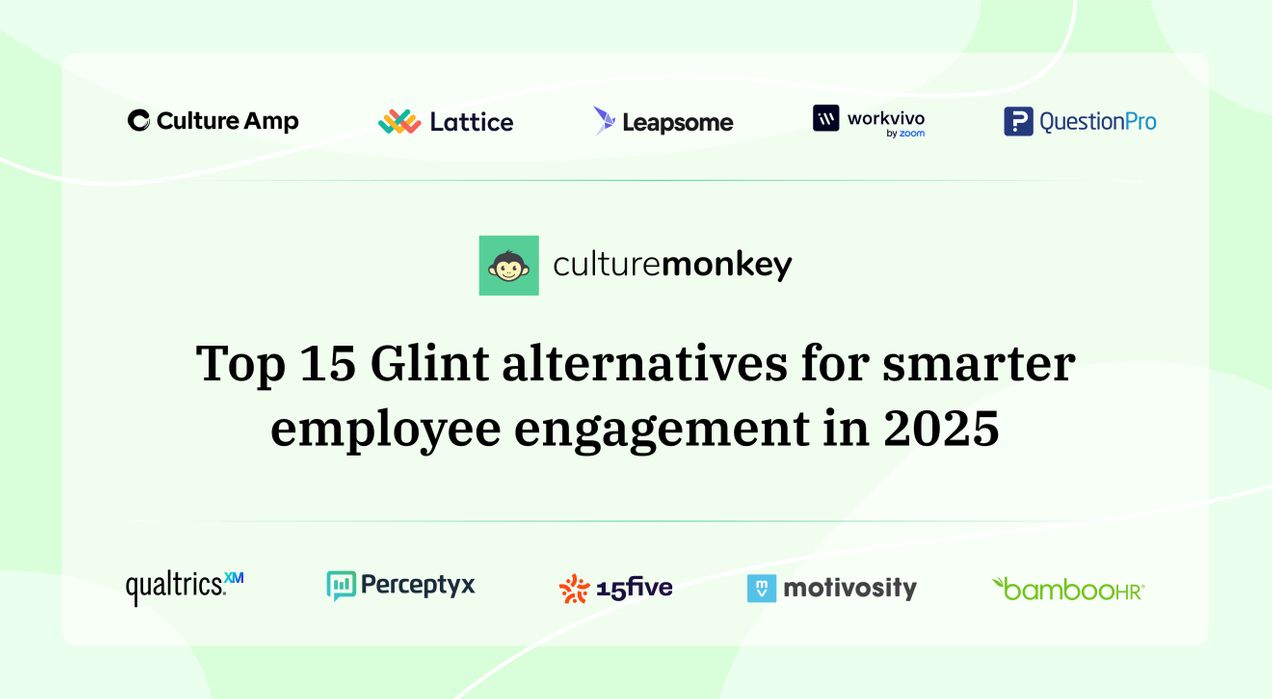20+ Employee engagement tips to boost motivation and retention in 2025

Imagine a bicycle with all its parts intact, but the chain is loose. No matter how strong the rider or how smooth the road, progress is slow and frustrating. That loose chain? It’s a disengaged workforce.
Even with the best tools, without connection and motivation, the ride feels harder than it should. Employee engagement is the chain that links effort to outcome, ideas to action, and individuals to team success.
Tighten it, and suddenly the wheels turn faster, the ride gets smoother, and momentum builds. In 2025, with hybrid models and evolving roles, leaders must focus on strengthening that chain to keep teams moving forward with energy and purpose.
TL;DR
What is employee engagement, and why does it matter in 2025?

TL;DR
Employee engagement is the emotional commitment employees feel toward their work, team, and company goals. Engaged employees go beyond task completion—bringing energy, initiative, and alignment with business success. They care, contribute, and help shape a positive, high-performance workplace.
In 2025’s fast-moving job market and remote-first world, engagement is key to retaining talent, building connection across distributed teams, and maintaining culture, innovation, and well-being at scale.
Employee engagement is the emotional commitment an employee has toward their work, team, and organization. It goes beyond job satisfaction and employee satisfaction—engaged employees care about their performance and the company’s success.
They’re motivated, proactive, and aligned with business goals, contributing ideas, energy, and effort that help drive growth, innovation, and align with organizational goals, fostering stronger workplace relationships across all levels.
Retention is a rising challenge
The job market in 2025 is fast-paced and full of tempting opportunities. Employees are no longer afraid to switch jobs if they feel undervalued or disconnected.
Investing in employee engagement helps create a workplace people want to stay in, which is key for employee retention, net thriving employees, reducing turnover, and protecting the time, energy, and cost spent on rehiring and retraining.
Remote work requires a deeper connection
Remote and hybrid teams are now the norm. But without a shared physical space, it’s easy for employees to feel isolated or invisible. High engagement ensures remote employees stay emotionally invested, involved in the company culture, and connected to their coworkers—even if they haven’t met in person all year.
Motivated teams drive better results
When employees feel genuinely engaged, they bring more than just task completion—they bring energy, ownership, and innovation.
Engaged teams don’t wait for instructions; they solve problems, chase improvement, and take pride in their output. That kind of drive, along with effective leadership development, directly boosts overall performance and team effectiveness.
Mental well-being affects performance
Burnout and stress aren’t just HR buzzwords; they’re daily hurdles. Engaged employees are more likely to feel supported, understood, and mentally safe at work.
By prioritizing engagement, companies can lower absenteeism, increase focus, and create a work environment where people thrive, supporting their emotional wellbeing without draining themselves dry, thus avoiding lost productivity.
Brand reputation depends on happy employees
Today’s candidates don’t just read job descriptions—they read employee reviews. Engaged employees are more likely to promote your company, leave positive reviews, and refer to great talent. On the flip side, actively disengaged employees can quickly damage employer branding through low ratings and candid (and often brutal) online feedback.
Innovation thrives in engaged cultures
A disengaged workforce won’t take creative risks or voice new ideas—they’ll just do the minimum. But an engaged one? That’s where ideas flourish. When people feel safe, valued, and inspired, they contribute freely and often. This fuels continuous innovation, making your business more agile and competitive in 2025’s shifting market.
How engagement impacts retention and productivity

TL;DR
Engaged employees stay longer, perform better, and care more deeply about outcomes. Their focus, accountability, and emotional investment reduce costly turnover while boosting quality of work.
They solve problems faster, take initiative, and collaborate across teams—fueling productivity even under pressure. Their trust and ownership enable companies to innovate, improve, and thrive with fewer roadblocks and higher consistency.
When employees feel seen, heard, and valued, they don’t just stay longer—they perform better. Engagement fuels motivation, loyalty, and focus, making it a key driver of both retention and productivity in 2025, as seen in highly engaged employees.
Below are the key ways engaged employees create a lasting impact.
- Lower turnover rates: Engaged employees feel connected to their role and the company’s purpose. They’re less likely to browse job boards or entertain recruiter calls. This saves time, money, and energy spent on replacing talent.
- Higher quality of work: Employees who care about what they do are more likely to catch mistakes, go the extra mile, and deliver thoughtful results. Engagement raises the bar on consistency and craftsmanship.
- Increased ownership and accountability: Engaged teams don’t wait for micromanagement—they take initiative. They treat projects like their own, take responsibility for outcomes, and look for ways to improve processes without being asked.
- Faster response to challenges: When employees are engaged, they don't freeze in the face of setbacks. Instead, they adapt, troubleshoot, and bounce back quicker, keeping productivity levels high even under pressure.
- Better collaboration across teams: Engagement fosters trust and open communication. Employees feel more comfortable working together, sharing feedback, and solving problems as a unit, especially across departments.
- Boosted innovation and ideas: Engaged employees feel safe to speak up and contribute fresh ideas. They’re more likely to offer creative solutions, challenge the status quo, and help move the company forward.
- Stronger emotional investment in outcomes: When employees are engaged, they’re emotionally invested in results, not just ticking boxes. Their commitment drives performance, builds pride in their work, and naturally improves overall productivity.
20+ Actionable employee engagement tips for managers and HR teams

Engagement doesn’t happen by accident—it’s built through everyday actions, consistent support, and intentional strategies.
Whether you manage five people or five hundred, these employee engagement tips, including development opportunities, can help you create a more connected, motivated, and loyal workforce in 2025.
1. Start with onboarding
First impressions matter. A clear, personalized, and welcoming onboarding experience helps new hires feel confident, included, and excited from day one. When people feel supported early, their long-term engagement skyrockets.
2. Embrace the company's core values and mission
Employees want to work for something bigger than just profit. Regularly communicate your mission and values, and more importantly—live them. This alignment creates purpose and strengthens emotional connection to the company.
3. Promote team activities
Bonding isn’t just a “fun extra”—it’s a key to collaboration. Whether it’s virtual trivia, lunch-and-learns, or small team challenges, group activities help build trust and reduce silos across teams.
4. Growth opportunities
Nobody wants to feel stuck. Offer lateral moves, cross-training, stretch projects, or learning stipends to help employees explore various career paths. Career development fuels ambition and shows employees there’s a future worth investing in at your company.
5. Recognize and reward employees
A simple “great job” goes a long way—but structured recognition systems go even further. Tie rewards to company goals or values to reinforce what matters. It boosts morale and deepens motivation.
6. Survey employees
Regular employee pulse surveys give teams a voice and show you care about their perspective. Use quick, focused surveys to check in on morale, gather ideas, and spot engagement gaps early.
7. Volunteer days
Giving back together creates an emotional connection and social impact. Offer paid volunteer time or organize team-building activities and service projects. It supports employee values while enhancing team bonding and goodwill.
8. Emphasize healthy work-life balance
Burnout kills productivity and engagement. Encourage real-time off, support realistic workloads, and respect boundaries. When employees feel their personal lives are valued, they stay more focused and loyal at work.
9. Encourage teamwork
Teamwork isn’t automatic—it’s cultivated. Promote collaboration through shared goals, group projects, and peer recognition. Cross-functional teamwork builds camaraderie and gives employees a sense of shared purpose.
10. Check employee wellness
Mental and physical health and well-being impact performance. Offer wellness resources like counseling support, fitness reimbursements, or no-meeting Fridays. Checking in regularly shows that health is not just a checkbox—it’s a priority.
11. Create a positive work environment
Engagement thrives in safe, upbeat spaces. Create an atmosphere where people feel respected, trusted, and included. Small cultural shifts—like open dialogue, fair policies, and light humor—can make a big difference.
12. Flexible work schedules
Rigid 9-to-5 models no longer fit everyone. Offering flexibility—through remote options, asynchronous work, or compressed weeks—empowers employees, engages and shows trust, especially for employee engagement for remote teams.
13. Measure engagement
Guesswork doesn’t cut it. Use data from employee pulse surveys, performance reviews, and sentiment analysis to track what’s working. Measuring regularly helps you respond in real time with smarter strategies.
14. Prioritize feedback
Feedback fuels growth and clarity. Create systems for both giving and receiving feedback that are respectful and regular. Employees who feel heard and guided stay more engaged over time.
15. Professional development
Support employees in building new skills through training, certifications, or conferences. Professional development is one of the best employee engagement strategies because it helps people evolve with the company.
16. Recognize success
Celebrate wins—big and small. Shoutouts during meetings, internal newsletters, or peer-nominated awards all reinforce good work. Regular recognition keeps motivation high and aligns teams with shared goals.
17. Build a diverse and inclusive culture
People feel more engaged when they see themselves reflected and respected. D&I efforts go beyond hiring—include inclusive policies, affinity groups, and cultural celebrations to make belonging real.
18. Clear communication
Confusion is the enemy of engagement. Prioritize clarity in everything—from team goals to company changes. Use multiple channels to keep everyone informed and reduce misunderstandings before they become disengagement.
19. Consistent employee development
Growth shouldn’t be a once-a-year topic. Offer regular check-ins, coaching, and learning resources throughout the year. Consistency helps employees feel supported in their long-term career advancement journey.
20. Create mentorship opportunities
Mentorship builds connections across experience levels. Whether formal or informal, pairings between new and seasoned employees foster trust, learning, and stronger cultural ties—especially in larger or remote teams.
21. Encourage innovation
Employees are more engaged when they’re empowered to think creatively. Welcome new ideas, test employee engagement programs, and remove the fear of failure. Innovation builds ownership and excitement across teams.
22. Encourage transparency
Don’t keep employees guessing. Share context behind decisions, admit when things don’t go as planned, and involve employees in planning when possible. Transparency breeds trust and commitment.
23. Give recognition
Recognition can be public, private, verbal, or tangible—but it should always be sincere and specific. Regular appreciation energizes teams and remains one of the easiest employee engagement ideas to execute.
24. Hold employees accountable
Accountability isn’t punishment—it’s purpose. When expectations are clear and everyone is held to the same standard, people trust leadership more. Accountability reinforces responsibility and strengthens engagement through fairness.
Common challenges companies face when boosting engagement

Trying to improve engagement sounds simple—until you start doing it. Many companies dive in with good intentions but hit walls they didn’t expect. Here are seven common challenges that can quietly sabotage even the most enthusiastic engagement efforts.
1. One-size-fits-all strategies
What works for one team might flop with another. Applying a single engagement strategy across diverse departments or demographics can feel impersonal. Employees want relevant, tailored experiences that actually speak to their roles and challenges.
2. Infrequent or vague feedback loops
Asking for feedback once a year won’t cut it. And when feedback does come in, if leaders don’t act on it or respond vaguely, employees tune out. Engagement drops quickly when people feel their voices lead nowhere.
3. Burnout from constant change
Too many new tools, processes, or “fun initiatives” can backfire. Change fatigue is real, and when engagement feels like just another task on the to-do list, employees resist it. Timing and pacing matter.
4. Remote work disconnect
For employee engagement for remote teams, a lack of face time and informal connections can lead to isolation and impact how employees feel valued. When managers don’t adapt engagement tactics for distributed teams, those employees often feel forgotten or undervalued.
5. Misalignment between values and actions
If a company claims to value transparency but makes decisions behind closed doors, trust erodes. Employees disengage when there’s a disconnect between stated values and day-to-day actions. Consistency is key to credibility.
6. No clear way to measure success
Engagement is often treated as a vibe, not a metric. Without setting benchmarks, tracking engagement through employee pulse surveys, or defining what success looks like, teams can’t improve what they can’t measure.
7. Lack of leadership buy-in
If leadership isn’t fully behind engagement initiatives, they won’t go far. When leaders see engagement as “an HR thing” rather than a company-wide priority, it loses momentum. Without visible support from the top, employees may not take the efforts seriously.
The connection between employee engagement and company culture

TL;DR
Culture sets the tone for engagement—shaping how people behave, feel, and connect to the organization. A strong culture creates emotional alignment, psychological safety, and clear expectations that reduce confusion and energize performance.
Engaged employees become culture carriers, reinforcing shared values through everyday actions. Their pride, positivity, and trust in leadership make company culture a living force that scales across teams and time.
Company culture and employee engagement are deeply intertwined, like two sides of the same coin. You can’t build one without influencing the other. A thriving culture fuels engagement, while engaged employees continuously shape and strengthen culture.
- Culture sets the tone for engagement: The behaviors, values, and norms in your company culture influence how employees show up every day. If the environment is inclusive, respectful, and energizing, engagement levels naturally rise. Toxic or inconsistent cultures, on the other hand, repel motivation.
- Shared values create emotional alignment: When employees believe in the company’s mission and see those values in action, they connect on a deeper level. This emotional alignment boosts engagement, commitment, and the desire to contribute beyond job descriptions.
- Culture influences trust and transparency: An open, transparent culture makes employees feel safe to speak up, ask questions, and share ideas. That psychological safety leads to greater engagement—people lean in when they know they won’t be ignored or penalized.
- Recognition becomes part of the everyday: In high-engagement cultures, appreciation isn’t reserved for annual reviews—it’s part of daily interactions. When recognition is embedded into culture, employees feel valued, boosting morale and strengthening retention.
- Culture drives collaboration: A strong culture promotes teamwork and shared accountability. When teams trust each other and celebrate wins together, it builds a sense of community. That camaraderie directly fuels engagement and a desire to support others.
- Engaged employees reinforce culture from the inside: Engaged employees live out company values through their actions and decisions. They become culture carriers who influence others—especially new hires—through positivity, initiative, and pride in their work.
- Cultural clarity reduces confusion and disengagement: When expectations are clear and behaviors are aligned across departments, employees don’t waste energy decoding the workplace. A consistent culture helps people focus on their work, stay productive, and feel confident in how they fit into the bigger picture.
How technology and AI are reshaping engagement strategies

Gone are the days when engagement was measured by a once-a-year survey and a pizza party. In 2025, tech and AI are transforming how companies connect with employees, making strategies smarter, faster, and more personal. Here are five ways digital tools are changing the game.
1. Real-time employee pulse surveys
AI-powered platforms now help HR teams run quick, regular check-ins with employees. These employee pulse surveys gather insights in minutes, track engagement trends, and help managers act quickly—before problems grow.
2. Personalized engagement experiences
AI can tailor recommendations, development plans, and even recognition messages based on an employee’s role, preferences, and behavior. This kind of personalization makes employees feel seen, valued, and supported at an individual level.
3. Predictive analytics for retention
Advanced analytics can identify patterns that signal disengagement or flight risk. Managers get proactive alerts and suggested actions, allowing them to intervene early and improve employee engagement for remote teams or high-risk departments.
4. Automated feedback loops
Instead of waiting for quarterly reviews, AI tools help gather continuous feedback, process it, and loop it back to managers in digestible formats. This keeps engagement efforts aligned and responsive.
5. AI-enabled coaching and learning
Modern platforms use AI to recommend training modules, mentorships, or career tracks based on goals and performance. These smart development paths support career growth, an essential part of improving employee engagement in today’s workforce.
The role of leadership in driving engagement across teams
TL;DR
Leaders shape engagement by modeling trust, energy, and purpose. Their behaviors influence how teams collaborate, communicate, and stay motivated. Engagement rises when leaders listen, recognize, and provide clarity.
High-impact leaders act on feedback, mentor team members, and champion inclusion—creating belonging and loyalty. In 2025, leadership is less about direction and more about emotional connection, growth, and cultural alignment.
Leadership isn’t just about setting goals—it’s about setting the emotional tone. In 2025, employees look to their leaders for more than just direction; they want authenticity, connection, and purpose. Here are seven ways leaders play a central role in driving employee engagement, tips that truly stick.
- Modeling the right behaviors: Engaged leaders create engaged teams. When managers show up with energy, curiosity, and integrity, employees tend to mirror that mindset. Leadership behavior sets the standard for how people work, communicate, and collaborate every day.
- Creating a culture of trust: Trust is the foundation of engagement, and leaders build or break it through consistency. Transparent communication, owning mistakes, and following through on promises show employees that their leaders are dependable and worth following.
- Offering recognition and appreciation: Recognition from a direct manager carries more weight than most perks. Leaders who give timely, specific praise help reinforce desired behaviors and boost morale. It’s one of the simplest yet most effective employee engagement ideas.
- Listening and acting on feedback: Engaged leaders actively listen and respond. When employees see their suggestions being acknowledged or acted upon, they feel respected and empowered. This responsiveness builds loyalty and fuels continuous improvement.
- Driving clarity and alignment: Confusion leads to disengagement. Leaders keep teams focused by clarifying goals, roles, and expectations. With clear direction, employees know what success looks like and how their work contributes to the bigger picture.
- Supporting growth and development: Leaders play a big role in mentoring, coaching, and opening up growth paths. Whether it’s helping with career plans or recommending learning opportunities, their involvement directly impacts improving employee engagement and retention.
- Fostering inclusivity and belonging: Great leaders make space for every voice. By being aware of bias, championing inclusivity, and ensuring everyone is heard, they cultivate a culture where people feel safe to engage, innovate, and contribute fully.
How CultureMonkey helps HR leaders act on employee feedback

TL;DR
CultureMonkey turns employee feedback into meaningful action. With automated pulse surveys and AI-powered insights, HR teams detect sentiment shifts and uncover risks early—without drowning in raw data.
The platform offers tailored action plans for managers, builds transparent feedback loops, and integrates seamlessly with existing tools—empowering HR to close the feedback-action gap and embed engagement into daily workflows.
Collecting feedback is easy. Acting on it? That’s where most companies struggle. CultureMonkey bridges this gap by helping HR leaders not only gather insights but also turn them into meaningful action. Here's how the platform drives employee engagement tips that actually stick.
1. Automated employee pulse surveys
CultureMonkey allows HR teams to run customizable employee pulse surveys on a regular cadence. These short, data-driven check-ins help capture real-time sentiment and uncover engagement challenges before they spiral into bigger issues.
2. AI-powered insights and analytics
Instead of sifting through endless survey responses, CultureMonkey uses AI to surface trends, sentiment shifts, and red flags. HR leaders get clear, actionable data that supports workplace engagement strategies with speed and precision.
3. Personalized action plans for managers
The platform doesn't just dump data—it recommends specific actions based on feedback themes. Managers get tailored engagement strategies that make it easy to respond and improve team dynamics quickly.
4. Feedback loops that close the gap
CultureMonkey enables transparent communication by allowing leaders to follow up on feedback, share outcomes, and show employees how their voices lead to change, boosting trust and improving employee engagement consistently.
5. Seamless integration with existing tools
It fits right into your tech stack, integrating with the communication and HR systems you use. This streamlines feedback workflows, boosts adoption, and helps create a culture of continuous improvement without extra hassle.
Conclusion
As work models evolve and employee expectations rise, companies must invest in strategies that make people feel valued, connected, and heard. From onboarding to feedback to growth opportunities, every moment matters.
But engagement isn’t a one-time campaign—it’s a continuous conversation. That’s where tools like CultureMonkey come in.
By helping HR leaders capture real-time insights and take meaningful action, CultureMonkey turns employee feedback into real engagement outcomes. Whether your team is remote, hybrid, or in-office, it’s time to stop guessing what your employees need and start listening.
Summary
FAQs
1. How can managers improve employee engagement quickly?
Managers can quickly boost engagement by offering sincere recognition, asking for feedback, and showing genuine interest in employee well-being. Simple actions like check-ins, public shoutouts, and listening actively make employees feel valued. Creating psychological safety and setting clear expectations also builds trust and motivation, making it easier to re-engage teams without complex programs or delays.
2. Why is employee engagement important for retention?
Engaged employees are emotionally connected to their work and more likely to stay committed long-term when they receive employee recognition. They feel seen, heard, and aligned with company goals, reducing the urge to seek opportunities elsewhere. Strong engagement builds loyalty, lowers turnover costs, and creates a stable workforce that performs better, adapts faster, and grows with the organization instead of leaving it.
3. What role does feedback play in employee engagement?
Feedback is essential for engagement because it creates two-way communication. Employees want to know where they stand and feel their input matters. When feedback is timely, specific, and acted upon, it builds trust, improves performance, and shows that leadership values employee voices—making people more invested in their roles and connected to the workplace.
4. What are the most cost-effective engagement strategies?
Low-cost engagement strategies, as well as effective employee engagement strategies, include peer recognition, regular one-on-one check-ins, and transparent communication. Encouraging feedback, celebrating small wins, and promoting flexibility also go a long way. These actions require little to no budget but create a meaningful impact by making employees feel respected, heard, and supported in their work, while providing actionable insights without the need for expensive programs or tools.
5. Can employee engagement be measured through surveys?
Yes, employee engagement can be effectively measured using regular surveys, especially employee pulse surveys. These quick, focused check-ins track sentiment, motivation, and satisfaction over time. When analyzed correctly, survey data helps HR and managers identify engagement trends, address pain points, and create targeted actions to improve team morale and retention continuously.



